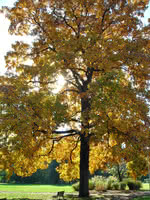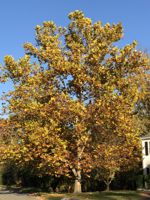Mon-Fri 9am - 5pm Mountain time
Shagbark Hickory vs American Sycamore
Carya ovata
Platanus occidentalis
NOT AVAILABLE THIS SEASON - MIGHT RETURN
Shagbark Hickory is a unique tree both for its looks and uses. Its bark peels into long thin vertical strips giving it a shaggy appearance. This and its golden fall leaves make it a gorgeous looking tree. This species produces tasty hickory nuts once mature. Hickory smoke is also treasured for curing meats and its generally fantastic smell.
This tree is best planted away from any buildings due to a deep taproot and large size. Many people remark on the unusual taproot for this tree that can be over 6 feet deep while the plant only has 2 feet of top growth.
American Sycamore is the largest tree native to eastern North America. Generally too large and messy to be a street tree, American Sycamore thrives in large, open spaces, such as an acreage or farm.
The bark is one of the main features that draw people to this tree. The outer bark flakes off in irregular pieces to reveal an attractive white, green, and cream colored inner layer, providing winter interest.
American Sycamore has an extremely fast growth rate, gaining up to 6 ft in one year, and will easily reach its mature height in a short period of time. Be wary of this trees' root system, as it's typically very extensive and needs lots of room to expand.

